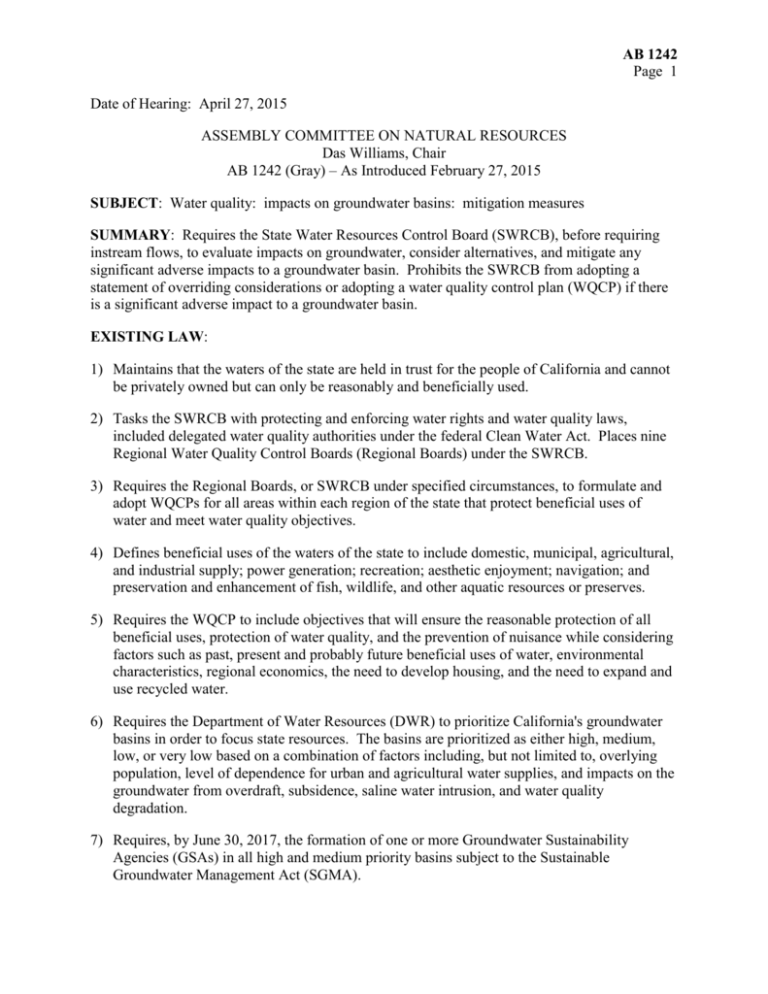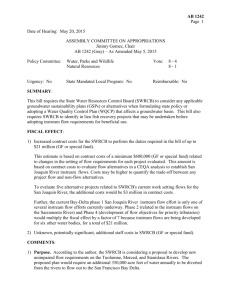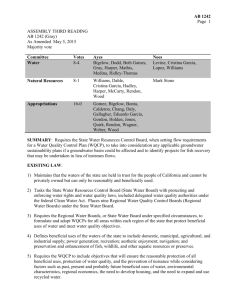Natural Resources
advertisement

AB 1242 Page 1 Date of Hearing: April 27, 2015 ASSEMBLY COMMITTEE ON NATURAL RESOURCES Das Williams, Chair AB 1242 (Gray) – As Introduced February 27, 2015 SUBJECT: Water quality: impacts on groundwater basins: mitigation measures SUMMARY: Requires the State Water Resources Control Board (SWRCB), before requiring instream flows, to evaluate impacts on groundwater, consider alternatives, and mitigate any significant adverse impacts to a groundwater basin. Prohibits the SWRCB from adopting a statement of overriding considerations or adopting a water quality control plan (WQCP) if there is a significant adverse impact to a groundwater basin. EXISTING LAW: 1) Maintains that the waters of the state are held in trust for the people of California and cannot be privately owned but can only be reasonably and beneficially used. 2) Tasks the SWRCB with protecting and enforcing water rights and water quality laws, included delegated water quality authorities under the federal Clean Water Act. Places nine Regional Water Quality Control Boards (Regional Boards) under the SWRCB. 3) Requires the Regional Boards, or SWRCB under specified circumstances, to formulate and adopt WQCPs for all areas within each region of the state that protect beneficial uses of water and meet water quality objectives. 4) Defines beneficial uses of the waters of the state to include domestic, municipal, agricultural, and industrial supply; power generation; recreation; aesthetic enjoyment; navigation; and preservation and enhancement of fish, wildlife, and other aquatic resources or preserves. 5) Requires the WQCP to include objectives that will ensure the reasonable protection of all beneficial uses, protection of water quality, and the prevention of nuisance while considering factors such as past, present and probably future beneficial uses of water, environmental characteristics, regional economics, the need to develop housing, and the need to expand and use recycled water. 6) Requires the Department of Water Resources (DWR) to prioritize California's groundwater basins in order to focus state resources. The basins are prioritized as either high, medium, low, or very low based on a combination of factors including, but not limited to, overlying population, level of dependence for urban and agricultural water supplies, and impacts on the groundwater from overdraft, subsidence, saline water intrusion, and water quality degradation. 7) Requires, by June 30, 2017, the formation of one or more Groundwater Sustainability Agencies (GSAs) in all high and medium priority basins subject to the Sustainable Groundwater Management Act (SGMA). AB 1242 Page 2 8) Requires, by January 31, 2020, that GSAs in all high and medium priority basins subject to a chronic condition of overdraft develop and adopt Groundwater Sustainability Plans (GSPs) that provide for the sustainable management of the groundwater basin, as defined. 9) Requires, by January 31, 2022, that GSAs in all other high and medium priority basins subject to SGMA develop and adopt GSPs. 10) Allows the SWRCB to impose an interim plan for management of a groundwater basin if no GSA is formed by the deadline, no GSP is adopted by the appropriate deadline, or a GSP is adopted which DWR deems insufficient and where the basin is in a chronic condition of overdraft or in a condition where groundwater pumping is causing a significant depletion of interconnected surface waters. THIS BILL: 1) Requires the SWRCB to consider GSPs when formulating state policy for water quality control and adopting or approving a WQCP. 2) Requires, before adopting instream flows that protect beneficial uses of water, that the SWRCB evaluate impacts on groundwater basins (i.e., from increased groundwater pumping in reaction to increased instream flow requirements) and consider alternatives and mitigation measures to avoid or mitigate any adverse impacts on groundwater quality or supply to the extent feasible. 3) Requires the SWRCB to adopt and implement mitigation measures for any significant adverse impacts to a groundwater basin caused by increased groundwater pumping. 4) Prohibits the SWRCB from adopting a WQCP if there is a significant adverse impact to a groundwater basin caused by increased groundwater pumping. FISCAL EFFECT: Unknown COMMENTS: 1) Background. For 30 years the State Water Project and federal Central Valley Project and others have been required to help meet flow requirements in the Sacramento-San Joaquin Delta (Delta), but the tributaries to the San Joaquin River avoided any requirements other than experimental flows. The SWRCB is now engaged in a long-delayed process to determine what level of flows should be provided by the tributaries. This bill would prohibit the SWRCB from imposing in-stream flow requirements on tributaries to the San Joaquin River unless the SWRCB pays for actions to mitigate when local water users pump more groundwater in response to the loss of surface water dedicated to in-stream flows. The Merced, Tuolumne and Stanislaus Rivers are tributaries to the San Joaquin River. The San Joaquin River flows northward to join the Sacramento River in the Delta. The Delta's flow provides part of the drinking water supply for two-thirds of the state's population and water for a multitude of other urban uses as well as supplying some of the state's most productive agricultural areas both inside and outside of the Delta. The Delta is also one of the largest ecosystems for fish and wildlife habitat production in the United States, including commercial runs of salmon. AB 1242 Page 3 The SWRCB is responsible for protecting and managing both water rights and water quality in California. As part of its duties, the SWRCB developed a Delta WQCP in 1995 that included requirements as to how much water must be left in-stream at different times to protect and balance all beneficial uses of water including municipal and industrial, agricultural, recreational, and fish and wildlife. After adopting the Delta WQCP, the SWRCB commenced a water rights proceeding to determine the responsibilities of water rights holders to implement the flow-dependent objectives in the Delta WQCP. The water rights proceeding was massive and included parties with water rights on the Sacramento River and its tributaries, San Joaquin River and its tributaries, and in the Delta. The hearing was divided into 8 regional phases and the SWRCB encouraged parties to reach settlement agreements with other water rights holders and interested parties as a way of proposing allocations of responsibility to meet the flow-dependent objectives. During Phase 2 of the hearing, parties on the San Joaquin River and its tributaries submitted the San Joaquin River Agreement proposing an allocation of responsibility for releasing "pulse flows" to the Delta during the April-May and October periods, which are most critical to migrating salmon. The parties argued there wasn't sufficient information to determine how much water was needed instream for fish and, therefore, they would also conduct an experiment during the April-May period called the Vernalis Adaptive Management Plan (VAMP). Under VAMP, parties on the tributaries to the San Joaquin River were paid a fixed amount of money by the federal government in return for maintaining low, medium, and high releases during different years that would be tied to low, medium, and high levels of export water by the State Water Project and federal Central Valley Project pumping plants in the Delta. The objective was to evaluate the relative relationship between flows down the San Joaquin and export pumping in the Delta on fish survival. VAMP ended in 2011 after more than a decade during which the full range of flows and export limitations were never provided to complete the experiment and, meanwhile, populations of at-risk fish species crashed in the Delta. The Delta WQCP received a minor update in 2006 but identified, as part of that update, four "emerging issues" including the decline of pelagic or "open water" fish such as smelt and threadfin shad; climate change impacts; Delta and Central Valley salinity; and, San Joaquin River flows. With regard to San Joaquin River flows, the SWRCB referenced data that showed various fish species within the Delta and San Joaquin River basin that had not shown significant signs of recovery since adoption of the VAMP experiment and recommended additional study. Thereafter, in 2009, the SWRCB commenced a triennial update of the WQCP that is ongoing and will include a determination of what responsibility parties on the individual tributaries to the San Joaquin River have for contributing to Delta flows. Parties on the tributaries to the San Joaquin River have advised that if they are required to leave more flows in-stream they will simply pump more groundwater. As a result, they maintain, it is the SWRCB's potential action that will be responsible for additional degradation of their groundwater basins. In this bill they seek to have the SWRCB analyze the potentially significant impact of a local increase in groundwater pumping on the basin and then require the SWRCB and not local entities mitigate for any increased degradation. The most likely mitigation that the SWRCB would require in accordance with this bill is adoption of a GSP pursuant to SGMA. However, all basins on the eastern side of the San Joaquin River are already ranked as high priority and thus are already required to adopt a AB 1242 Page 4 SGMA plan or submit an alternative plan that meets SGMA's requirements by the appropriate deadlines. 2) Author's statement: For the past year, the SWRCB has considered a proposal to develop new unimpaired flow requirements on the Tuolumne, Merced, and Stanislaus rivers. The proposed plan would require an additional 350,000 acre feet of water annually to be diverted from the rivers to flow out to the San Francisco Bay Delta. If adopted, the Board’s proposal will devastate the groundwater basins in the Valley by reducing surface water recharge opportunities and eliminating surface water deliveries to domestic and agricultural water users. The Board recognizes these impacts would have significant “but unavoidable” adverse impacts to the region. In 2014, the Legislature passed the Sustainability Groundwater Management Act which promised to empower local communities with the tools to achieve sustainable management goals. The adoption of the Board’s proposal without mitigating measures would deny Central Valley basins one of the most important tools in that tool box: the ability to recharge the depleted groundwater table with surface flows. AB 1242 would ensure that the Board consider and mitigate the adverse impact of any new water quality control plan. It would also require the Board to implement mitigation measures to reduce identified significant adverse impacts, and would prohibit the adoption of plans with adverse impacts that cannot be sufficiently mitigated. REGISTERED SUPPORT / OPPOSITION: Support Agricultural Council of California Building and Construction Trades Council of Stanislaus, Merced, Tuolumne and Mariposa Counties California Women for Agriculture California Farm Bureau Federation City of Atwater City Council City of Ceres, Office of the Mayor City of Dos Palos, Office of the Mayor City of Gustine City Council City of Livingston, Office of the Mayor City of Los Banos, Office of the Mayor City of Merced, Office of the Mayor City of Modesto, Office of the Mayor City of Patterson, Office of the Mayor City of Turlock, Office of the Mayor Coalition of California Utility Employees Electrical Workers of Stanislaus, Merced, Tuolumne and Mariposa Counties Glenn-Colusa Irrigation District Greater Merced Chamber of Commerce AB 1242 Page 5 Harris Farms IBEW Local 1245 Latino Community Roundtable League of California Cities Central Valley Division Merced County Board of Supervisors Merced County Farm Bureau Board of Directors Merced Irrigation District Modesto Chamber of Commerce Modesto Irrigation District Northern California Water Association Stanislaus Business Alliance Stanislaus County Board of Supervisors Stanislaus County Chapter of California Women for Agriculture Stanislaus County Farm Bureau Stevinson Water District Turlock Chamber of Commerce Turlock Irrigation District Western Growers Association Yosemite Community College District Yosemite Farm Credit Association One individual Opposition California League of Conservation Voters Center for Biological Diversity Coastal Environmental Rights Foundation Clean Water Action Community Water Center Friends of the River Klamath Riverkeeper Leadership Counsel for Justice and Accountability Natural Resources Defense Council Sierra Club California The Nature Conservancy Union of Concerned Scientists Analysis Prepared by: Lawrence Lingbloom / NAT. RES. / (916) 319-2092








